Key Components of a Human Resource Information System
Understand key components of HRIS like database, payroll, and compliance. Optimize HR operations now. Click to explore more!
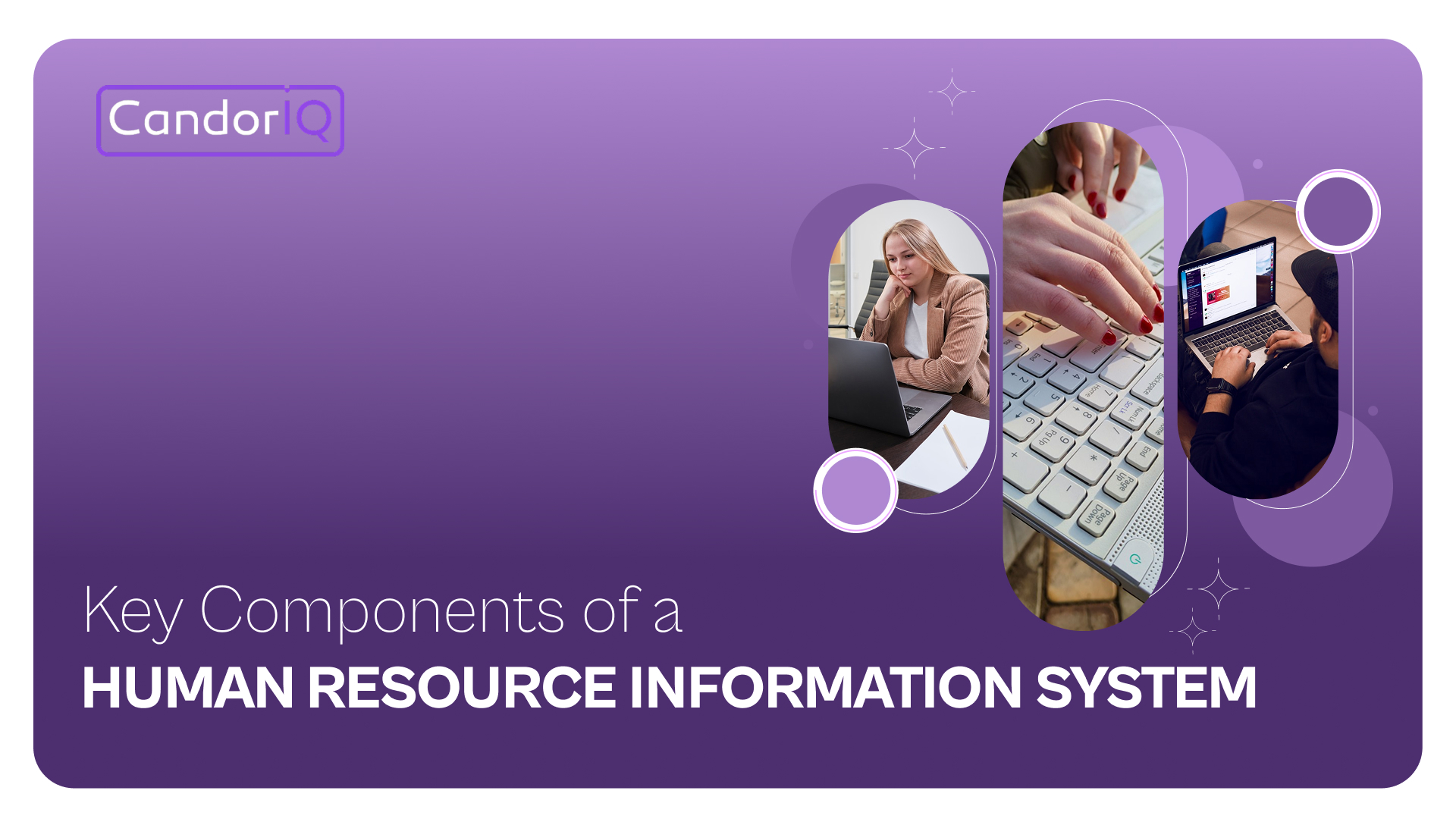
HR Tech Has Evolved. Has Your HRIS Caught Up?
People operations used to be all about paperwork. Today, it is about clarity. When you are scaling fast and managing hybrid teams across locations, even small gaps in HR data can snowball into bigger problems like delayed onboarding, missed compliance checks, or talent slipping through the cracks.
That is where a Human Resource Information System, or HRIS, steps in. But not all systems are built the same. A modern HRIS is not just a digital filing cabinet. It is the system that helps HR and operations leaders see what is happening in real time, across people, processes, and performance.
For HRBPs, CHROs, and People Analytics leads in fast-moving SaaS, fintech, and professional services companies, the right HRIS offers more than data management. It helps you scale smarter, align people strategy with business goals, and get ahead of challenges before they escalate.
Before you can evaluate whether your current system supports scale and agility, it's essential to understand what a comprehensive HRIS should include. Let’s break down the key components that power an effective Human Resource Information System.
TL;DR
- An HRIS is more than an employee database. It streamlines core HR operations, enhances compliance, and supports better decision-making.
- Essential components include: Employee data management, Payroll, Attendance, Applicant tracking, Performance and learning tools, Benefits, compliance, and workforce analytics
- A modern HRIS helps HR teams shift from admin-heavy tasks to strategic people management
- Ideal for fast-scaling SaaS, fintech, and professional services firms that need structure and visibility at speed
Employee Information Management
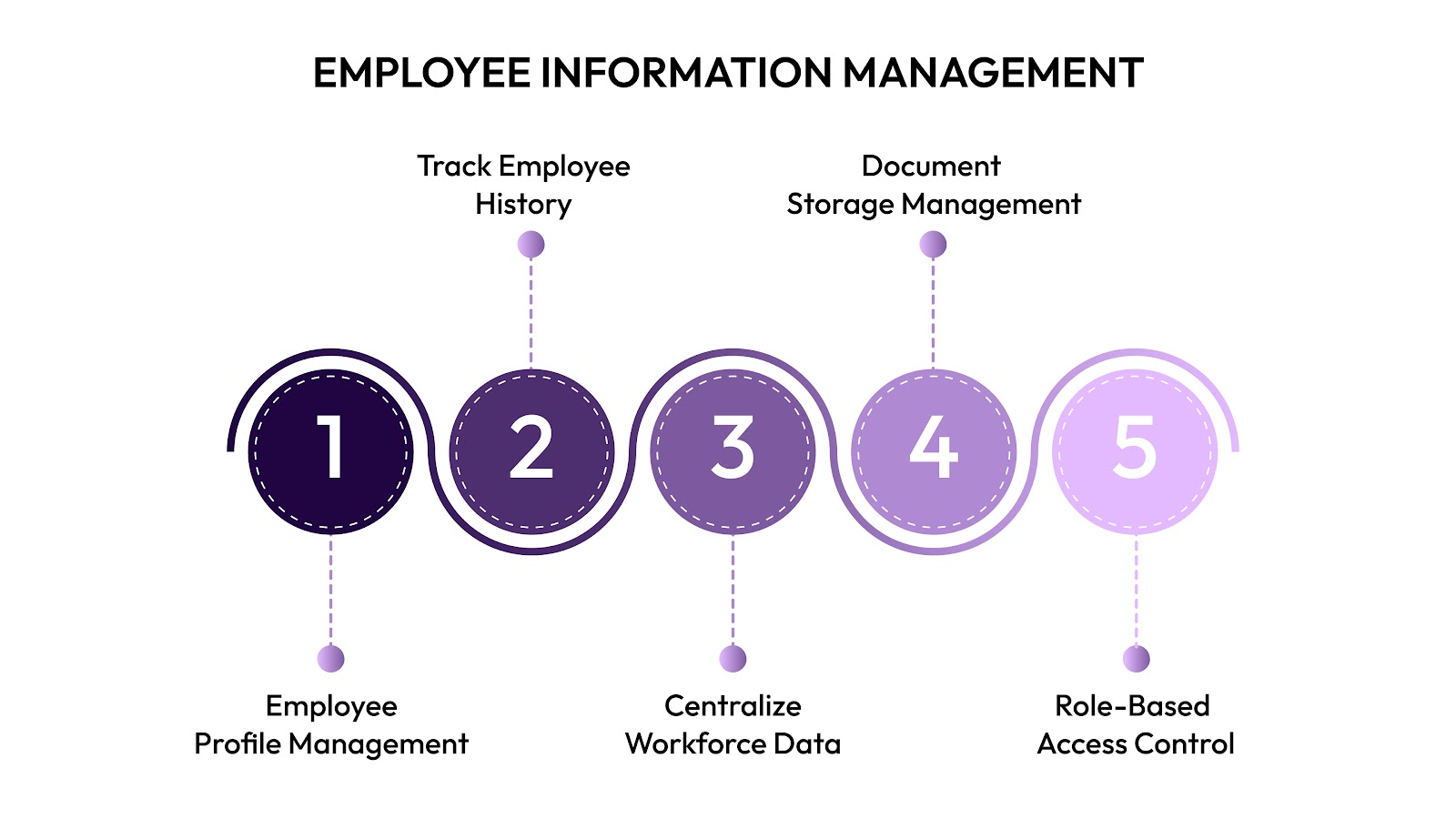
Every HRIS begins with the basics: managing employee data. This component acts as the digital record keeper for your entire workforce and forms the foundation for every other HR function.
A strong employee information management system should allow you to:
- Maintain detailed employee profiles, including job titles, departments, contact information, and reporting structures
- Track employment history, promotions, certifications, and performance records
- Organize workforce data in one place to simplify audits, compliance, and reporting
- Manage document storage for offer letters, ID proofs, contracts, and more
- Control access to sensitive information with role-based permissions
When this core is solid, HR teams spend less time chasing files and more time supporting people.
Payroll Management
Accurate and timely payroll isn’t just about getting people paid; it’s about building trust across your workforce. A well-integrated payroll component within your HRIS eliminates manual errors, reduces compliance risks, and saves countless hours for HR and finance teams.
Key features of payroll management in an HRIS include:
- Automated salary calculations based on attendance, leaves, bonuses, and deductions
- Built-in compliance with tax laws, local labor regulations, and statutory reporting
- Direct deposit capabilities and payslip generation
- Support for multi-country or multi-currency payroll, ideal for global or remote teams
- Integration with time tracking, benefits, and accounting systems to ensure consistency across departments
With payroll centralized in your HRIS, you reduce reliance on spreadsheets and third-party processors while ensuring employees are paid correctly, every time.
Numbers don’t lie, but they need context. Ready to go from HR reporting to real workforce insights? [Book your personalized walkthrough]

Time and Attendance Tracking
Time and attendance tracking goes beyond just clock-ins and outs; it offers a real-time view of workforce availability, shift patterns, and productivity trends. Within an HRIS, this component ensures managers always have accurate, centralized data to support decision-making and workforce planning.
Key functions typically include:
- Real-time visibility into who is working, where, and for how long
- Custom shift scheduling and roster management for teams across time zones
- Automated alerts for missed punches, overtime thresholds, or attendance anomalies
- Seamless sync with leave management systems for holistic absence tracking
- Mobile access for remote or field-based employees
By combining attendance data with broader workforce analytics, HR teams can detect absenteeism trends, forecast staffing needs, and improve resource utilization without chasing down timesheets.
Recruitment and Applicant Tracking (ATS)
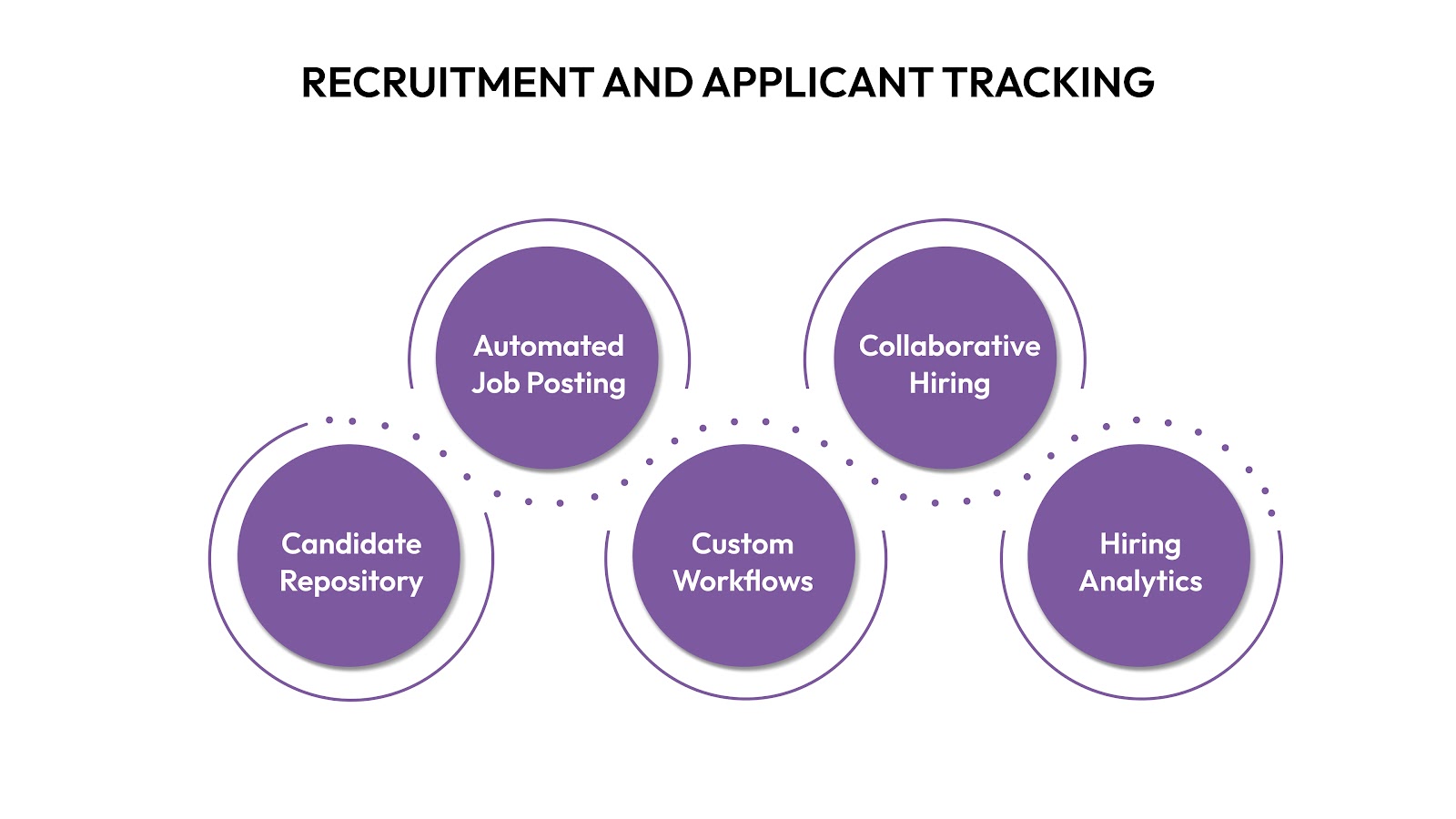
Modern recruitment is no longer about juggling resumes in email folders or spreadsheets. The ATS component of an HRIS helps streamline and structure the entire hiring process; from sourcing to onboarding while keeping every stakeholder in sync.
Key capabilities include:
- Centralized database for candidate profiles, resumes, and communication
- Job posting automation across multiple platforms
- Workflow customization for different hiring stages and roles
- Real-time collaboration between recruiters, hiring managers, and interviewers
- Built-in analytics to track time to hire, source effectiveness, and pipeline health
An integrated ATS doesn’t just save time. It helps teams hire faster, reduce drop offs, and ensure a consistent candidate experience across roles and departments.
Onboarding and Offboarding
The employee journey starts and ends with moments that define long-term perception. A structured onboarding and offboarding process ensures consistency, compliance, and clarity for both HR teams and employees.
What onboarding looks like in a modern HRIS:
- Preboarding checklists to streamline documentation before day one
- Automated provisioning of tools and accounts
- Role-based workflows that align with department-specific onboarding plans
- Integration with ONA tools to monitor early network connections
- Feedback loops to improve onboarding effectiveness continuously
On the offboarding side, an HRIS should handle:
- Task automation across IT, payroll, legal, and facilities
- Exit interview tracking and insights collection
- Knowledge transfer workflows to retain critical information
- Access deprovisioning to mitigate security risks
- Compliance logging for audits and documentation
These components make it easier for HR teams to manage transitions without dropping the ball. Offboarding is no longer an administrative task but a chance to protect IP, preserve culture, and close the loop with dignity.
Performance Management
An effective HRIS does more than store performance reviews. It enables a continuous performance cycle by aligning individual goals with team outcomes and organizational priorities.
Key features to look for in this component include:
- Role-specific goal setting that ties into team and department OKRs
- Periodic check-ins and real-time feedback mechanisms
- Integration with 360-degree feedback tools for cross-functional inputs
- Calibration workflows to ensure fairness and transparency
- Analytics dashboards to spot high performers and at-risk talent
When performance data connects with collaboration patterns and organizational context, HR teams can drive stronger development conversations, identify future leaders early, and align rewards with impact.
Learning and Development (L&D)
In high-growth environments, learning cannot be a static, one-size-fits-all offering. The L&D component of an HRIS needs to support continuous, personalized, and performance-aligned development.
Capabilities to prioritize include:
- Centralized course libraries with role-specific recommendations
- AI-powered learning paths that adapt based on skill gaps and goals
- Integration with performance data to align learning with outcomes
- Real-time progress tracking and certification management
- Cross-team learning analytics to monitor participation and impact
L&D becomes a strategic lever when learning data connects back to engagement, retention, and internal mobility. It allows HR and People teams to close capability gaps before they impact performance.
Curious how high-performing teams stay aligned on goals and development?
[See how better performance data powers better talent decisions]
Benefits Administration
Benefits are more than perks. They are a core part of employee satisfaction, retention, and total compensation strategy. The Benefits Administration module in an HRIS must offer flexibility, transparency, and ease of use for both HR teams and employees.
Look for capabilities such as:
- A self-service portal where employees can view, select, and modify benefits
- Automatic eligibility checks and enrollment tracking across regions or plans
- Real-time sync with payroll to ensure accurate deductions and tax reporting
- Vendor integrations to manage healthcare, insurance, and retirement plans
- Data analytics to evaluate benefit utilization and improve plan offerings
When benefits data flows seamlessly across payroll, compensation, and employee records, HR leaders can make better decisions and reduce administrative load.
Compliance and Reporting
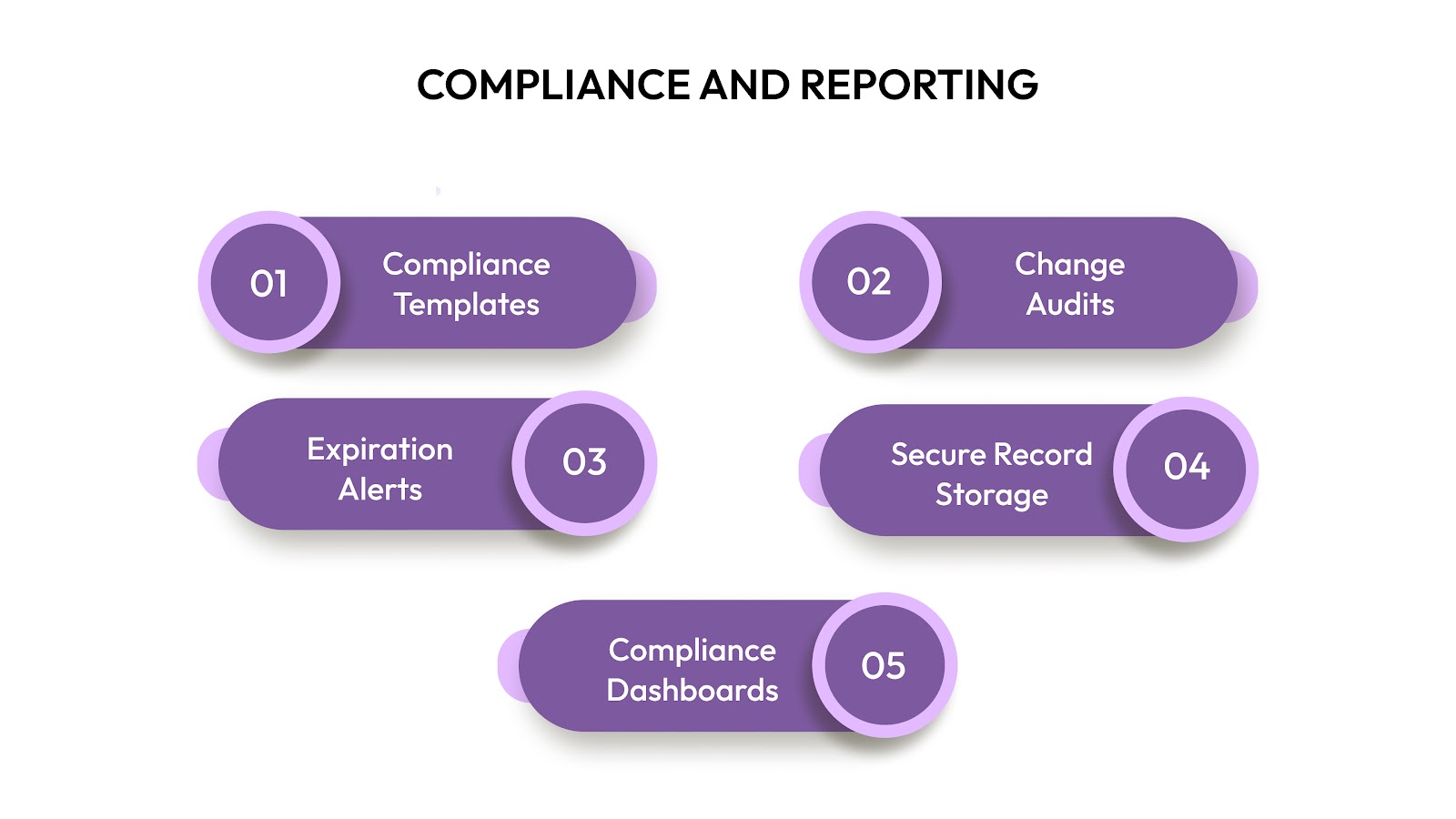
Staying compliant is not just about ticking boxes. It protects your organization from legal, financial, and reputational risks. A strong HRIS should simplify compliance by automating tracking, documentation, and reporting.
Key features to expect:
- Pre-configured templates for labor laws, EEO reporting, and GDPR compliance
- Audit trails for employee changes and policy acknowledgments
- Automated alerts for expiring certifications, contract renewals, or visa documentation
- Secure storage of records to support internal audits and external inspections
- Real-time dashboards to track compliance metrics across departments and geographies
With proactive compliance monitoring built into the system, HR teams can focus more on people and less on paperwork.
Employee and Manager Self-Service Portals
Modern HRIS platforms empower employees and managers to access information and take action without waiting for HR intervention. This improves efficiency, reduces bottlenecks, and enhances the employee experience.
Look for features like:
- Personalized dashboards for each user role
- Access to pay slips, leave balances, benefits, and policy documents
- Ability to update personal data, request time off, and track application status
- Mobile compatibility to ensure access from anywhere
- Workflow triggers that notify managers and HR of pending actions
By enabling employees to manage basic tasks independently, HR leaders can redirect time toward strategic initiatives.
Workforce Analytics and Dashboards
Data-driven decision-making is critical to workforce planning and people strategy. An HRIS should turn raw data into actionable insights through user-friendly dashboards.
What best-in-class systems include:
- Visual dashboards highlighting key HR metrics like turnover, absenteeism, and engagement
- Predictive analytics to flag attrition risk, hiring needs, and leadership gaps
- Drill-down capabilities to analyze data by department, location, or job function
- Customizable reports for finance, compliance, and board-level summaries
- Real-time data syncing to eliminate reporting delays and errors
Workforce analytics move HR from a reactive to a strategic function, helping companies align talent decisions with business outcomes.
How CandorIQ Adds a Strategic Layer to HRIS
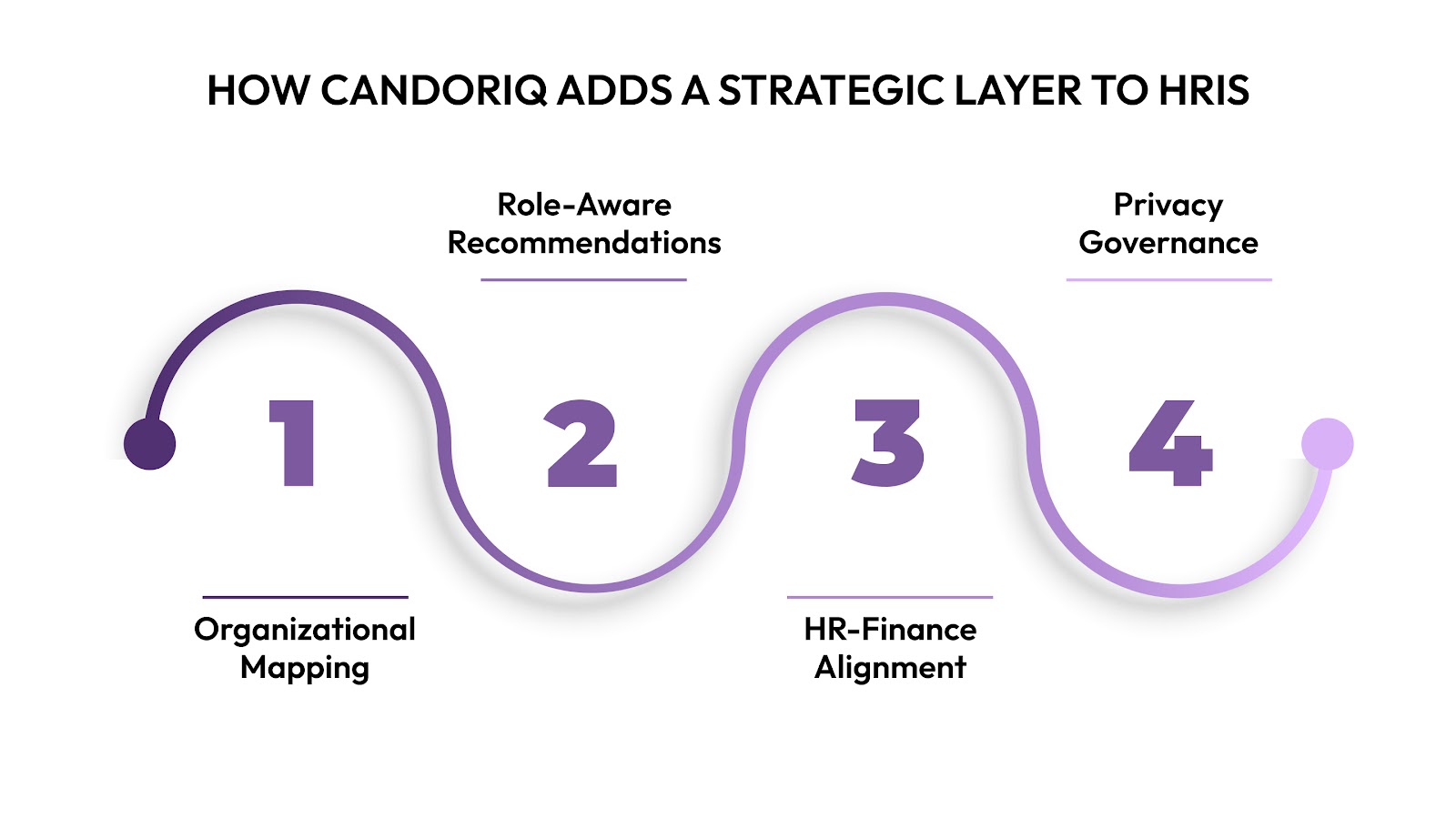
Most HRIS platforms stop at collecting and storing data. CandorIQ goes further by turning that data into continuous insight and action. For fast-scaling SaaS, fintech, and professional services companies, this strategic intelligence is essential for navigating change, aligning people with business priorities, and optimizing workforce investments.
Real-Time Organizational Mapping
CandorIQ integrates seamlessly with your existing HRIS and communication tools to create a live map of how collaboration, influence, and decision-making actually work across your organization. This gives HRBPs and People Analytics teams visibility that static org charts and quarterly reports can’t offer.
- See how new hires are integrating, where silos are forming, and which teams are thriving
- Detect early signs of disengagement, burnout, or change resistance through interaction patterns
- Identify informal influencers and collaboration gaps long before they show up in exit data
Role-Aware Recommendations
The platform doesn’t just show network patterns. It tells you what to do about them. Insights are personalized by role and context, helping both HR and business leaders act with precision.
- CHROs get a clearer picture of how people strategy impacts productivity and retention
- HRBPs receive nudges to initiate check-ins or rebalance workloads before friction escalates
- People Analytics leads gain behavioral context to explain survey scores and performance data
Unifying HR and Finance on Talent Decisions
CandorIQ enables better alignment between HR and Finance teams through shared visibility into how workforce structures translate to business outcomes. Instead of relying on headcount alone, organizations can base workforce planning on real collaboration, impact, and influence.
- Evaluate ROI on leadership development by tracking post-training network growth
- Improve compensation decisions by factoring in real-time contribution and network health
- Make informed trade-offs during reorganizations or team expansions with live org intelligence
Built-In Privacy and Governance
CandorIQ is designed with trust in mind. Sensitive metadata is anonymized, securely processed, and made available only to authorized roles. The system adheres to strict compliance and ethical standards so leaders get the insight they need without compromising employee trust.
If your current HRIS is helping you track data but not understand what’s happening behind it, CandorIQ can bridge that gap. It brings clarity, actionability, and strategic depth to workforce decisions that fast-growing companies cannot afford to delay.
A Smarter HRIS Starts With the Right Layer
A Human Resource Information System is more than just a digital filing cabinet. It is the foundation for how your organization handles everything from hiring and payroll to performance and compliance. But having the components in place is not enough. What matters is how well they work together to give you clarity, control, and foresight.
For HR leaders, People Analytics teams, and Finance partners navigating rapid growth, that clarity must go beyond dashboards. It must reveal how teams connect, how work happens, and where action is needed now.
Ready to see how it fits into your HR tech stack? Book a personalized demo with CandorIQ and discover what a more connected, data-aware workforce can unlock for your organization.

Frequently Asked Questions
Q: What’s the minimum set of modules a growing company should start with?
A: At a minimum, you’ll need employee information management, payroll, time tracking, and a basic applicant tracking system. These help you centralize key HR processes and stay compliant as your team grows.
Q: Do we need a separate system for performance reviews and goal tracking?
A: Not necessarily. A modern HRIS usually includes a performance management module that lets you run reviews, set OKRs, and track feedback in one place. But make sure it integrates well with your org’s workflow style.
Q: How customizable are most HRIS platforms?
A: Leading platforms offer some customization in workflows, access controls, and dashboards. But deep customization often requires additional investment. It’s important to pick a platform that aligns closely with your existing processes.
Q: Can we manage compliance without a separate tool?
A: A good HRIS should support compliance through automated reporting, audit trails, and document management. But if you operate across multiple geographies, you’ll want features that support location-specific compliance needs.
Q: What if our HR and Finance teams both need access?
A: Most enterprise-grade HRIS platforms support role-based access, so HR, Finance, and IT can all work from the same source of truth. Look for platforms like CandorIQ that are designed for cross-functional collaboration.
Q: Will implementing an HRIS disrupt our current workflows?
A: There’s always a short transition period, but platforms with flexible integration options (e.g. Slack, Zoom, GSuite) minimize friction. Look for systems that mirror how your teams already work.
Q: Is an HRIS only useful for large enterprises?
A: Not at all. Fast-scaling mid-sized companies benefit even more from an HRIS. It reduces manual work, improves accuracy, and helps leadership make faster decisions during high-growth phases.
Q: What’s the difference between HRIS, HCM, and HRMS?
A: HRIS focuses on core data and process management. HCM (Human Capital Management) includes talent strategy and workforce planning. HRMS (Human Resource Management System) is often used interchangeably with HRIS, though some providers distinguish by scope. What matters most is how the platform solves your specific problems.


